- Understanding Air Duct Cleaning
- What is Air Duct Cleaning?
- The Air Duct Cleaning Process
- How Air Duct Cleaning Affects Utility Bills
- Airflow and Energy Consumption
- System Performance and Lifespan
- Indoor Air Quality and Health
- Duct Cleaning Solutions
- Professional Air Duct Cleaning
- Duct Sealing and Insulation
- Clean Air Ducts Can Have an Effect on Energy Costs
- Energy Efficiency
- HVAC Performance
- How Often Should You Clean Air Ducts?
- Recommended Cleaning Frequency
- Indicators for Cleaning
- Optimize Your Energy Efficiency with Air Duct Cleaning
- Frequently Asked Questions
- Does cleaning air ducts make a difference?
- What are the drawbacks of duct cleaning?
- How ductwork can be made more energy-efficient?
- How much energy is lost in ductwork?
- How can a duct system increase energy loss?
Keeping a comfortable home often comes with a cost, especially when it comes to heating and cooling. However, what if a simple solution could not only improve your indoor air quality but also save you money on your energy bills? If you've ever wondered, "How does air duct cleaning work to lower heating bills?" you're not alone. Many homeowners are seeking practical ways to cut costs without sacrificing comfort, and air duct cleaning could be the answer.
Imagine your HVAC system as the lungs of your home. Just as our lungs can struggle to function when filled with contaminants, dirty air ducts can hinder your HVAC system's efficiency. The result? Higher energy bills and less effective heating or cooling. In this article, we'll explore how air duct cleaning can address these issues and more.
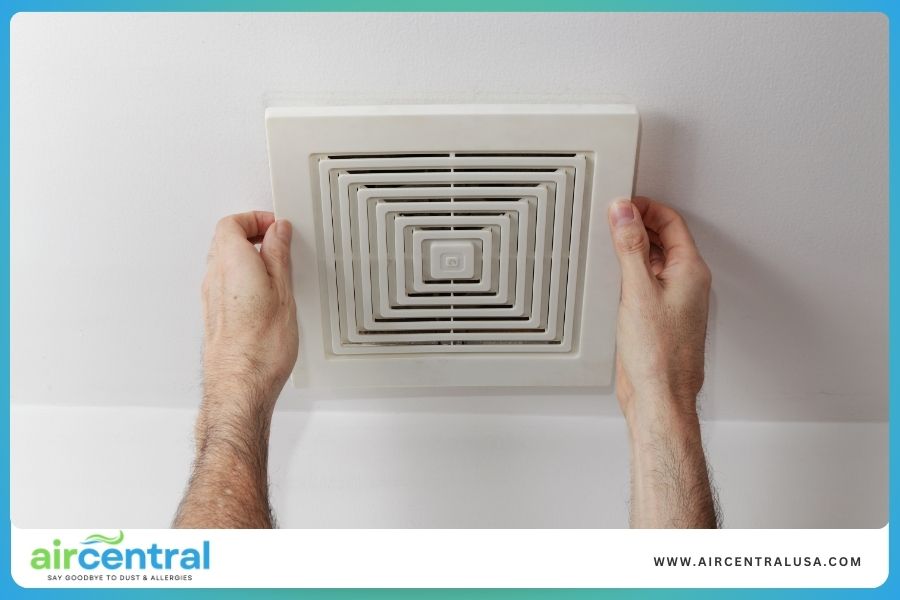
Here's what you can expect to learn:
- Understanding Air Duct Cleaning: Learn about the process and why it's important for HVAC efficiency.
- How Air Duct Cleaning Affects Utility Bills: Discover the impact of dirty ducts on energy consumption and system performance.
- Duct Cleaning Solutions: Explore the various solutions available, from professional cleaning to sealing and insulation.
- What Is Air Duct Cleaning?: Dive deeper into the specifics of the cleaning process.
- Clean Air Ducts Can Have an Effect on Energy Costs: Understand how clean ducts improve efficiency and save money.
- How Often Should You Clean Air Ducts?: Find out the recommended frequency and signs indicating it's time for cleaning.
With energy costs rising and many households becoming increasingly conscious of their environmental footprint, it's important to find ways to enhance efficiency and reduce unnecessary expenses. This article will not only answer the question of "How does air duct cleaning work?" but also provide actionable tips to optimize your home's heating and cooling efficiency.
Understanding Air Duct Cleaning
What is Air Duct Cleaning?
Air duct cleaning is a process focused on removing dust, debris, and other contaminants from the ductwork of HVAC systems. This practice is essential for several reasons:
Definition: Air duct cleaning is the comprehensive cleaning of the various heating and cooling system components of forced air systems, including the supply and return air ducts, grilles, diffusers, heat exchangers, and cooling coilsImportance: It's crucial for maintaining HVAC efficiency, improving indoor air quality, and ensuring energy efficiency
Common Contaminants: Over time, dust, dander, mold, and other pollutants can accumulate in the ducts, leading to a range of issues.
The Air Duct Cleaning Process
Air duct cleaning typically involves several steps to ensure thorough cleaning and sanitizing of the system:
- Inspection: The first step involves a thorough assessment of the ductwork to identify any issues or areas of concern. Duct inspection can highlight potential leaks, blockages, or contaminants.
- Cleaning Methods: Specialized equipment such as brushes, vacuums, and blowers are used to remove dust and debris from the duct system. The cleaning process may also involve high-powered tools to dislodge dirt and blockages.
- Sanitizing: In addition to removing debris, many services include the application of antimicrobial treatments to prevent the future growth of mold and bacteria.
Air duct cleaning is essential for maintaining energy efficiency and preventing system wear and tear. When air ducts are dirty, the air circulation is restricted, making the HVAC system work harder and consume more energy. This can lead to increased utility bills and reduced system lifespan. Regular duct cleaning helps improve indoor air quality, enhances HVAC performance, and can even prevent future issues by identifying potential problems early.
How Air Duct Cleaning Affects Utility Bills
Airflow and Energy Consumption
Restricted Airflow: When air ducts are dirty, they become clogged with dust, debris, and other contaminants, which restricts airflow. This forces HVAC systems to work harder, resulting in increased energy consumption and higher utility bills. By keeping ducts clean, airflow is optimized, and HVAC systems can operate more efficiently.
Energy Efficiency: Clean air ducts allow for efficient airflow, which directly impacts the energy efficiency of heating and cooling systems. With unimpeded airflow, HVAC systems can maintain desired temperatures with less energy, reducing overall power consumption and lowering utility bills.
Enhanced Circulation: Improved airflow distribution throughout the home is another benefit of clean ducts, which enhances heating and cooling efficiency. Clean ducts ensure that warm or cool air is evenly distributed, eliminating hot or cold spots and enhancing overall comfort while using less energy.
System Performance and Lifespan
System Wear and Tear: Dirty air ducts make HVAC systems work harder, leading to increased wear and tear on the system components. This extra strain not only reduces energy efficiency but also increases the likelihood of breakdowns and repairs. Regular duct cleaning helps maintain optimal performance and prolongs the system's lifespan.
Maintenance Costs: Regular air duct cleaning can significantly reduce maintenance costs. By preventing dirt and debris from clogging the system, the need for repairs is minimized, and the lifespan of HVAC components is extended. This results in fewer breakdowns and lower long-term maintenance expenses.
Filter Longevity: Clean air ducts mean cleaner filters, which reduces the frequency with which filters need to be replaced. Clean ducts help prevent dust and contaminants from clogging filters, thus enhancing filter longevity and reducing replacement costs.
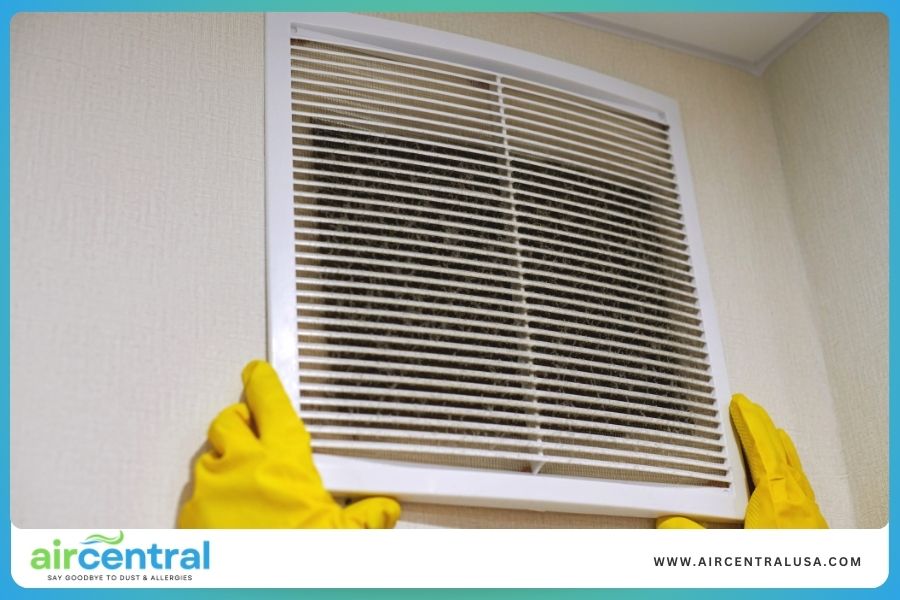
Indoor Air Quality and Health
Contaminant Reduction: Cleaning air ducts removes allergens, dust, and pollutants, which improves indoor air quality. This is especially important for individuals with allergies or respiratory issues, as clean air ducts can significantly improve breathing comfort and overall health.
Health Benefits: Improved indoor air quality can lead to better respiratory health and reduced symptoms of allergies or asthma. By removing harmful contaminants from the duct system, air duct cleaning contributes to a healthier living environment and enhances overall well-being.
Cleaning air ducts is not only beneficial for the performance and efficiency of HVAC systems but also plays a crucial role in maintaining a healthy home environment. By ensuring proper airflow, reducing system wear, and improving indoor air quality, air duct cleaning helps homeowners save money on utility bills while enhancing their comfort and health.
Duct Cleaning Solutions
Professional Air Duct Cleaning
Choosing a Service Provider: When selecting a professional for air duct cleaning, it's important to choose a certified and experienced provider. Look for NADCA-certified technicians who specialize in duct cleaning. Certified professionals adhere to industry standards and utilize the right equipment to thoroughly clean your duct system and enhance indoor air quality. It's also beneficial to read reviews and get recommendations to find a reputable service provider.
Cleaning Frequency: How often should you clean your air ducts? Experts recommend cleaning ducts every 3-5 years, although this frequency may increase for homes with pets, smokers, or allergy sufferers. Regular cleaning helps maintain energy efficiency, reduces utility bills, and ensures that HVAC equipment operates optimally. It's also wise to clean air ducts after major home renovations or if you notice significant dust buildup or unusual odors coming from the vent system.
Duct Sealing and Insulation
Importance: Proper duct sealing and insulation are crucial for preventing air leaks and minimizing energy loss. Leaky ducts can account for up to 30% of wasted energy, leading to higher heating and cooling bills. Sealing ducts help improve air circulation and ensure that conditioned air reaches the intended rooms, enhancing overall energy efficiency and comfort.
Methods: There are several effective methods for duct sealing and insulating ducts. Aeroseal, for example, is a popular technique that uses smart technology to seal cracks and holes from the inside out, creating an airtight duct system. Additionally, insulating exposed ducts in unconditioned spaces with radiant barriers or foam insulation helps slow heat loss and gain, further improving efficiency. Proper ductwork design and installation are also key to ensuring optimal performance and reducing power consumption.
When properly executed, air duct cleaning, sealing, and insulation solutions can enhance HVAC performance, improve indoor air quality, and lower energy consumption, leading to significant cost savings and a healthier home environment.
Clean Air Ducts Can Have an Effect on Energy Costs
Energy Efficiency
Enhanced Airflow: Clean air ducts facilitate smooth airflow, which directly impacts the energy efficiency of heating and cooling systems. When ducts are clean and unobstructed, the HVAC system operates more efficiently, consuming less energy to maintain the desired temperature in the home. This results in lower utility bills and reduced power consumption.
Lower Utility Bills: Improved energy efficiency translates into lower heating and cooling costs. When air ducts are free from contaminants like dust, debris, and mold, the HVAC system doesn't have to work as hard to circulate air, leading to significant cost savings on monthly utility bills. Proper duct cleaning also prevents issues like leaks and blockages, which can waste energy and increase heating bills.
HVAC Performance
Reduced Strain: Clean air ducts reduce the workload on HVAC systems, enhancing overall performance. Dirty or clogged ducts can cause the system to work harder, increasing wear and tear and potentially leading to breakdowns. Regular air duct cleaning ensures that the system runs smoothly, reducing strain on components and improving heating and cooling efficiency.
Extended Lifespan: Proper air duct cleaning also extends the lifespan of HVAC components. By preventing dirt and debris from building up in the system, the risk of damage or failure is minimized, which prolongs the life of the duct system, furnace, and air conditioner. This not only saves money on repairs but also delays the need for costly replacements.
Keeping air ducts clean is crucial for maintaining energy efficiency, lowering utility bills, and ensuring optimal HVAC performance. Clean air ducts enhance airflow, reduce strain on the system, and prevent issues that can lead to costly repairs or replacements. Regular duct cleaning is an effective way to save energy and money while improving the comfort and health of your home.
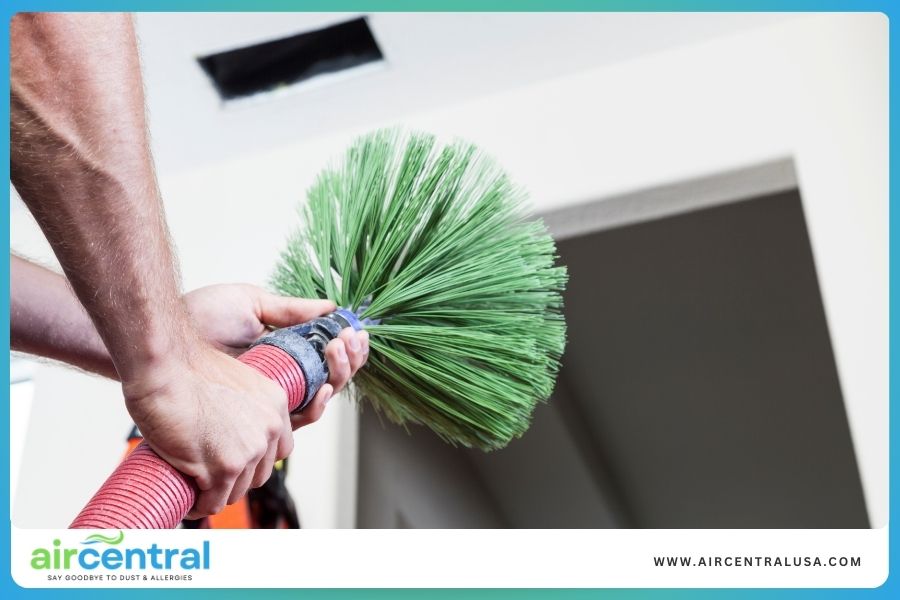
How Often Should You Clean Air Ducts?
Recommended Cleaning Frequency
General Recommendation: It’s generally recommended to clean air ducts every 3-5 years to maintain energy efficiency, indoor air quality, and HVAC performance. This interval is suitable for most households, as it allows for regular removal of accumulated dust, contaminants, and other debris.
Specific Cases: Some homes require more frequent air duct cleaning. For example, homes with pets, smokers, or residents with allergies may benefit from more regular cleaning. In these cases, contaminants like pet dander, smoke particles, or allergens can accumulate more rapidly in the ductwork, impacting indoor air quality and the efficiency of the HVAC system.
Indicators for Cleaning
Visible Dust: One clear indicator that air ducts need cleaning is the presence of visible dust or debris around vents or registers. This suggests that the ducts are circulating contaminated air, which can impact indoor air quality and energy consumption.
Allergy Symptoms: If household members experience increased allergy symptoms or respiratory issues, dirty ducts may be the culprit. Contaminants like mold spores, pollen, or dust mites can accumulate in the ducts and circulate through the home, exacerbating health issues.
High Energy Bills: Unexpectedly high energy bills can signal airflow issues due to dirty or clogged ducts. When ducts are blocked, the HVAC system has to work harder to maintain the desired temperature, increasing power consumption and utility costs.
Regular air duct cleaning is essential for maintaining a healthy, efficient home. By paying attention to the recommended cleaning frequency and indicators for cleaning, homeowners can enhance energy efficiency, improve indoor air quality, and extend the lifespan of their HVAC systems.
Optimize Your Energy Efficiency with Air Duct Cleaning
Clean air ducts are essential for maintaining energy efficiency, lowering utility bills, and improving indoor air quality. When air ducts are filled with dust, debris, or other contaminants, the HVAC system has to work harder to circulate air, leading to increased energy consumption and higher utility bills. Regular air duct cleaning helps improve airflow, enhances system performance, and prevents issues like mold growth, which can impact health and efficiency. By keeping air ducts clean, homeowners can extend the lifespan of their HVAC systems, improve indoor comfort, and save money on heating and cooling costs.
If you're looking to optimize your heating efficiency and improve the indoor air quality of your home, contact Air Central in Austin, TX. Their team of experienced professionals offers top-quality air duct cleaning services to ensure your HVAC system operates efficiently and effectively. By choosing Air Central, you can benefit from cleaner air, lower utility bills, and a healthier home environment. Schedule your air duct cleaning service today and enjoy the benefits of a clean and efficient heating system.
Frequently Asked Questions
Does cleaning air ducts make a difference?
Yes, cleaning air ducts can make a noticeable difference. Air duct cleaning removes dust, contaminants, and debris that accumulate over time. This process enhances airflow through the HVAC system, which can lead to improved energy efficiency and lower utility bills. Additionally, it can improve indoor air quality by reducing airborne allergens and particles, benefiting those with respiratory issues or allergies. Clean ducts also help maintain the system’s efficiency, preventing wear and tear that can lead to costly repairs. While not always necessary for every home, regular air duct cleaning is beneficial for those with pets, smokers, or residents with allergies, and in homes where visible dust or unusual odors are present around vents.
What are the drawbacks of duct cleaning?
While duct cleaning offers several benefits, it also has potential drawbacks. Some homeowners may find the cost of professional duct cleaning services prohibitive, especially if frequent cleaning is required. Improper cleaning techniques or unqualified technicians can damage ductwork or HVAC components, leading to more expensive repairs. Additionally, some cleaning methods may dislodge but not remove contaminants, causing them to be redistributed throughout the home. Overzealous or unnecessary cleaning can also disturb and potentially spread mold spores, leading to indoor air quality issues. It's important to use certified professionals and understand when duct cleaning is truly necessary to avoid these issues.
How ductwork can be made more energy-efficient?
Making ductwork more energy efficient involves sealing leaks, insulating ducts, and maintaining cleanliness. Duct sealing is crucial to prevent air leaks, which can account for up to 30% of wasted energy in HVAC systems. Insulating ducts in unconditioned spaces, such as attics or crawl spaces, prevents heat loss and gain, improving efficiency. Regular air duct cleaning removes contaminants that restrict airflow, enhancing system performance. Additionally, ensuring ducts are properly sized and designed for the HVAC system improves air circulation and energy efficiency. Proper maintenance, including changing air filters and regular inspections, also contributes to efficient ductwork.
How much energy is lost in ductwork?
A significant amount of energy can be lost in ductwork due to leaks, poor insulation, and contaminants. In typical homes, about 20-30% of the air that moves through the duct system is lost due to leaks, holes, or poorly connected ducts. This energy loss increases utility bills and reduces system efficiency. Proper duct sealing, insulation, and regular cleaning can prevent these issues and improve energy efficiency. Ensuring ducts are correctly designed and sized for the HVAC system also helps minimize energy loss and maintain efficient heating and cooling.
How can a duct system increase energy loss?
A duct system can increase energy loss through leaks, blockages, or poor design. Air leaks occur when ducts are not properly sealed, allowing conditioned air to escape and unconditioned air to enter, which increases the workload on the HVAC system and raises utility bills. Blockages caused by dust, contaminants, or debris restrict airflow, making the system work harder and consume more energy. Poor duct design, such as improper sizing or routing, can also impede airflow and reduce efficiency. Addressing these issues through duct sealing, insulation, and regular air duct cleaning helps minimize energy loss and improve efficiency.
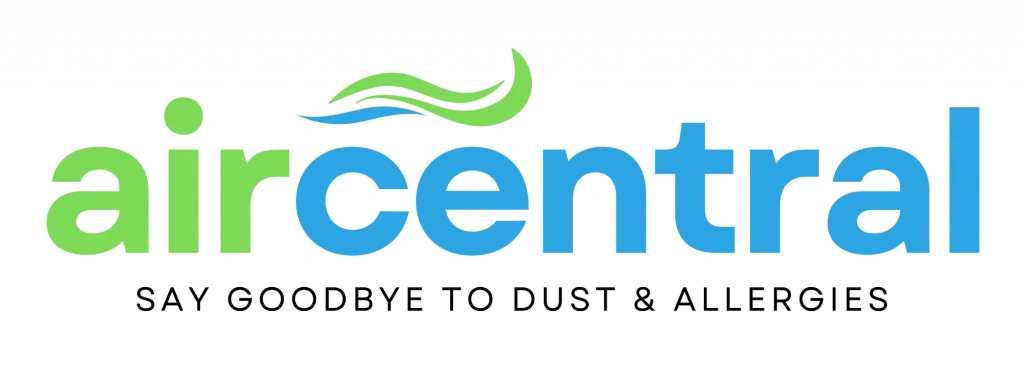


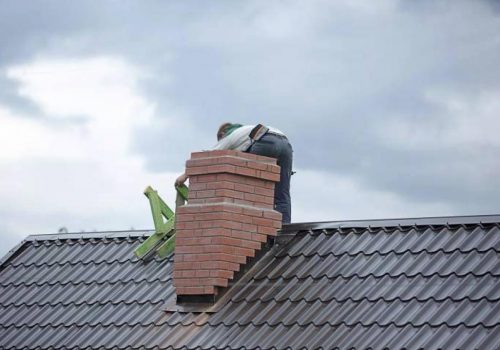


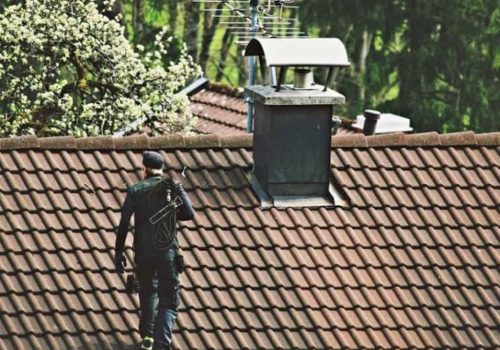
Comments: